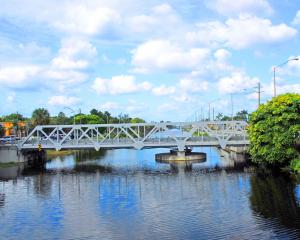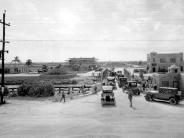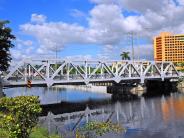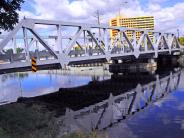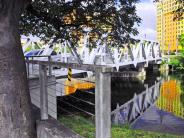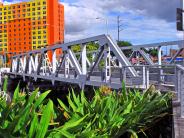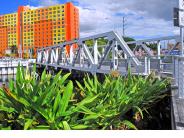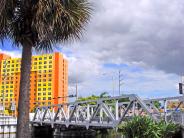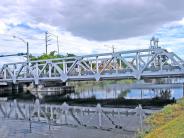Warren Pony Swing Bridge (incoming)
WARREN PONY SWING BRIDGE
(incoming)
Spans the Miami River Canal between Curtiss Parkway and 1st Street/Hialeah Drive
Designated Miami Springs Historic Site (1991)
When Glenn Curtiss and James Bright established the planned community of Country Club Estates as a division of Hialeah, the Miami River Canal separated the two communities. Completed in 1912 as one of the five major canals to drain the Everglades, this waterway also connected Lake Okeechobee with the Miami River, providing an important transportation route for commercial and pleasure craft, and playing a prominent historic and recreational role for the residents of the “River Cities.” Seminole Indians used this waterway as a main thoroughfare to trade at local shops and at the bank. Two existing boat basins for recreational craft were hand-dug in the canal bank, and saw heavy usage by residents, with the northernmost one mostly utilized by small outboard skiffs, row boats and canoes, and the southernmost (near the Parker Truss Vertical Lift Bridge) used for larger pleasure craft.
To replace a “three pontoon barge bridge”, the sum of $23,500 for the Warren Pony Swing Bridge was donated in 1923 to Dade County by city founder Glenn Curtiss in response to the heavy volume of both river and auto traffic. A bridge tender lived in a small house on the Hialeah side, and used a long metal pipe at the pivot pier to manually turn the bridge, usually with the help of some neighborhood children.
With the installation of the South Florida Water Management District’s S – 6 Saltwater Control Dam just downstream of 36th Street, commercial navigation of this area came to an end, and a 1941 restoration of the bridge removed the swing mechanism so that it remains fixed in a closed position.
This bridge was designed by the Pompano and Dania Bridge Company from Broward County, and fabricated and installed by the Champion Bridge Company of Ohio in 1924. It has a unique bobtail (off center) swing design that allows for the passage of larger vessels, the only one of its kind in the State of Florida. An outstanding example of the “pony” style (meaning that the roadway is lower than the through truss and has no overhead framework), it features a distinctive triangular Warren truss configuration that places both compressive and tensile stresses into the diagonal members, simplifying the configuration and number of panels needed. The bridge originally sported wooden decking and fendering, and was built on Dade County Pine pilings. Although it is now paved over, it is otherwise maintained in excellent structural condition and in its original appearance.
Click any thumbnail image to view a slideshow

